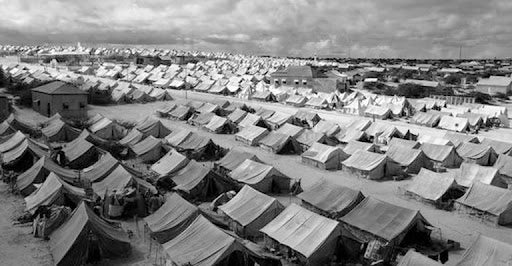If you’re seeking asylum, you had better be white.
Blue and yellow clothing. Blue and yellow flags. Blue and yellow hearts. Blue and yellow flowers—you’ve seen these things everywhere. The country of Ukraine has pulled at the heartstrings of the entire planet in what feels like such a short span of time.
Throughout the last few weeks, the world has watched in both shock and horror as Ukrainian civilians have had to flee for their lives in the midst of a possible war with Russia in an alleged fight to protect both the Donetsk and the Luhansk People’s Republics. There has been an outpouring of support for the Ukrainian people from millions around the world, many actively searching and spreading information about ways to contribute to what appears to be an impending humanitarian crisis. Various institutions, corporations and organizations of influence are even going as far as to donate funds to Ukraine and cut ties with Russia to protest what they see as an unnecessary and wrongful invasion.
In other words, the world is watching and has refused to stay silent on the matter. And it’s been very inspiring to watch everyone put aside their differences and pool their resources to try and support people who are in dire need.
However, many have speculated and asked an important question: what sets Ukrainians aside from other groups of refugees?
And, many have come to the same conclusion: they are white.
After all, when was the last time you heard of thousands putting red and blue hearts in their Twitter names for Haitians who were being whipped at the border? When was the last time you saw folks flying the Sudanese flag? When were people wearing clothes in awareness and support of people from Afghanistan? What about making infographics and sharing links about how to help Syrians who have been consistently under attack?
It’s likely that most of us have not heard about any of these countries and their refugees in weeks, unless we have some sort of direct connection to those countries.
This is quite disheartening to think about, as millions of people have been displaced within the last few decades. According to the United Nations High Commissioner for Refugees (UNHCR), more than two-thirds of all refugees in the world came from just five countries alone in 2019. These countries are Syria, Venezuela, Afghanistan, South Sudan and Myanmar. Other countries include the Democratic Republic of Congo, Palestine, Somalia, the Central African Republic, Eritrea, and many more.
Apparently, it seems like people could care less about refugees when they are Black and Brown. Maybe the rules have changed and seeking asylum is only for white folks. When have you ever seen refugees be embraced this heavily, especially from countries in the Northern cradle of the globe?
To add insult to injury, Western media outlets have not even tried at all to hide their biases in coverage of the crisis in Ukraine as things relate to that of other countries. Reporters from various networks have had no shame in emphasizing that these people deserve more empathy just based on the fact that they are white.
Charlie D’Agata, a senior foreign correspondent for CBS News, issued an apology on Saturday, February 26th for a statement he made the day before. He was under heavy fire the previous day when he made what many would consider a racist statement. He compared Ukraine to both Iraq and Afghanistan, saying that unlike those two countries, Ukraine is not normally a place where foreign conflict occurs.
“This is a relatively civilized, relatively European — I have to choose those words carefully, too — city, where you wouldn’t expect that or hope that it’s going to happen,” D’Agata stated.
On Sunday, February 27th David Sakvarelidze, Ukraine’s former deputy general prosecutor shared a strange reason on why the invasion of Ukraine bothered him so much in an interview with the BBC. "It's very emotional for me because I see European people with blue eyes and blonde hair being killed,” he said to a reporter.
Lucy Watson, an English correspondent for ITV News, reflected on the Ukrainian crisis by saying, “Now the unthinkable has happened to them. This is not a developing third world nation. This is Europe.”
It can’t be this hard to care about refugees from the third world, can it? Somehow, the answer is still a resounding “yes,” even if the refugees in question are also fleeing Ukraine and attempting to seek asylum. This has been the experience of many non-white individuals from the third world who reside in Ukraine as they have tried to leave the country for their own safety.
Many of these people are from Africa, Asia, and parts of the Middle East. According to the BBC, government data from 2020 found that Ukraine was home to over 76,000 foreign students, with around one quarter of these students being from African countries like Nigeria, Egypt, and Morocco. These students have been quite important to the Ukrainian economy, as they have been studying fields such as business, medicine, and engineering. This is not at all a new phenomenon; in fact, African students have been attending schools in Ukraine since the 1920s.
Countries like Yemen, Lebanon, Venezuela, India, Mexico and others have also seen an influx of people migrating elsewhere for various reasons, whether it be violence or economic issues. It’s important that all of their voices are uplifted and that we’re not prioritizing certain groups over others.
Let’s also be conscious of the fact that those who live in the global south often have to immigrate as refugees because the conditions they have been forced to live under were created by countries in the west, such as the United States, France, and the United Kingdom.
Many Syrian refugees, for example, have had to flee to Turkey due to the dangerous conditions and extreme violence in their home country. However, they face difficult living situations while seeking asylum as well as a lack of job opportunities in order to make a living and feed their families.
To state it plainly, the concept of asylum can often be a vicious cycle of white supremacy. A country’s economic affairs are destroyed by sanctions or war, resulting in a refugee crisis where people are forced to leave. Then, when refugees seek asylum, whether or not they are accepted with open arms often depends on where they are coming from and what they look like. And, when people of a darker pigment are required to flee some of the most violent situations for the sake of their livelihood, they are given little to no empathy.
This is the hypocrisy of Eurocentric asylum; if you want to utilize the fullest extent of your human rights, you better have blond hair and blue eyes. Otherwise, you’re just collateral damage.
With that being said, it is on us to change the cycle. Ukraine is not the only refugee crisis, and it likely won’t be the last. We must use our voices to demand attention and empathy for those whose struggles may go under the radar, so that the world isn’t allowed to pick and choose which groups to care about because of what they look like or the countries they come from—it’s not right. We must take up the torch of the human spirit and stress the concern and support of all groups, regardless of the color of their skin, or the texture of their hair.
We not only need to put pressure on our government to condemn NATO for its heinous actions, but we also need to advocate for refugees in Yemen, Somalia, Afghanistan, Palestine, Syria, and many other countries to name. We need to condemn the sanctions and acts of violence against those countries that take innocent lives and create more refugees who are left to deal with horrible situations. The world will not get better unless we push it that way first. Most importantly, it is on us to utilize our resources and study geo-political matters in order to better educate ourselves and contribute better to possible solutions. If we come to these situations unaware of the nuances and the issues at hand, we risk making things more difficult for those we are trying to help.

About the Author: Maryam Azeeza Muhammad is a poet, womanist, and journalism student from Bridgeport, CT currently attending Temple University in Philadelphia, PA.




JOIN THE DISCUSSION (0 comments)